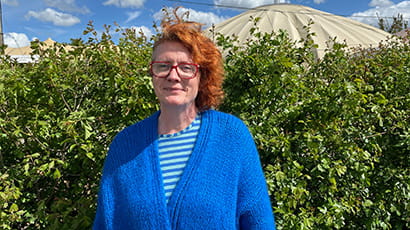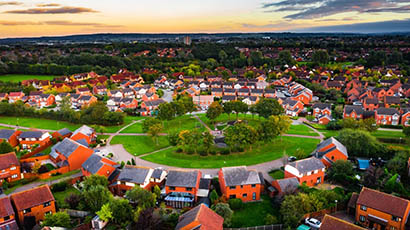Cemeteries offer same benefits as green spaces to urban dwellers, study finds

Cemeteries are just as valuable as green spaces for hundreds of thousands of people across England, new research suggests.
A study by academics at the University of the West of England (UWE Bristol) found that cemeteries provide the only access to doorstep green space for more than a million people in England, and offer many of the same benefits as parks.
Researchers found that cemeteries provide four per cent of accessible green space in England and are particularly important in high-density urban areas where space is limited. In some cities, cemeteries provide a historic setting for events and activities, a space for nature, and opportunities for community involvement, alongside their burial and crematoria services, the study found.
If planned for thoughtfully, the researchers concluded that new cemeteries could be deliberately multifunctional spaces; designed from the outset to provide benefits and functions for people and wildlife, in addition to remembrance. They are calling for new national policy guidance as well as increased funding to understand how cemeteries and green spaces could be planned and managed as more flexible spaces.
Danielle Sinnett, Professor in Sustainable Built Environments at UWE Bristol, said: “Cemeteries can contribute to the network of green spaces in our towns and cities, as places for recreation and nature conservation providing multiple benefits, or ecosystem services, including improved health and wellbeing, flood risk management, improvements in soil, water and air quality, pollination and climate adaptation. Often historically planned to sit on the outskirts of cities, older cemeteries now offer accessible spaces in the neighbourhoods that have grown up around them, where there may be little or no other greenspace, and limited possibilities to provide more.”
For their research, the academics examined the extent to which cemeteries in England provide accessible green space for people and, using Bristol as a case study, explored some of the benefits that they may provide as green spaces.
Using Ordinance Survey green space data, they found that out of the 120,876 green spaces in England, 4,992 are cemeteries (4.1 per cent). The amount of cemetery space in each local authority varies across England, from less than 5 hectares in some areas to 183.5 hectares in Birmingham. The proportion of green spaces that are cemetery space range from 0.24 per cent in West Lancashire to 31.4 per cent in the London Borough of Kensington and Chelsea.
The researchers, from UWE Bristol’s Centre for Sustainable Planning and Environments, found that in Bristol cemeteries are providing important functions as green spaces contributing to walking routes, providing spaces for rest and relaxation, and social interaction. Older cemeteries appeared to be primarily functioning as green spaces, the study found, whereas cemeteries that are (or were until recently) accepting burials appeared to be at more transitional stages providing some limited recreational function. Many cemeteries were providing space for nature with relatively mature trees; and vegetation in cemeteries was likely to be benefiting flood risk mitigation, cooling and air quality, according to the study.
Lead researcher Dr Katie McClymont, Associate Professor in Urban Planning at UWE Bristol, said: “Although the cemeteries we surveyed are providing many of the benefits of green spaces, planners and those managing and promoting these need to be attentive to the potentially competing needs of this ‘multifunctional’ space, such as diverse religious and spiritual practices around death and remembrance. To achieve this, we would like to see national policy guidance as well as increased funding for staff time to understand how cemeteries and green spaces could be planned and managed as multifunctional spaces. We would also like to see green infrastructure strategies incorporate specific proposals for increasing ecosystem service delivery in cemeteries. New cemeteries could also be specifically designed to incorporate features for ecosystem service delivery.”
The full academic research paper is available to view online.
Related news

16 April 2025
UWE Bristol academic paper named as one of this century’s most-cited
A UWE Bristol academic has co-authored the third most-cited academic paper of this century, according to new analysis released by research journal Nature.

16 April 2025
More than 80 UK projects receive nearly £1.2 million in first Immersive Arts funding round
Almost £1.2 million has been allocated to 83 artist-led projects across the UK.

11 April 2025
UWE Bristol academics among emerging scientific leaders to receive share of £7.6m funding for health research
Two UWE Bristol researchers are among the recipients of a £7.6 million investment from the Academy of Medical Sciences aimed at tackling urgent health challenges.

09 April 2025
New research to support a thriving health and care workforce is launched
A national research partnership will explore ways to support wellbeing and sustainability in the NHS and social care same day and urgent care workforce.

08 April 2025
Associate Professor named among newest members of UK Young Academy of emerging leaders
The Royal Society has named UWE Bristol’s Dr Alexandros Stratakos, Associate Professor and Principal Investigator in Sustainable Agri-Food Production, as one of the emerging leaders across the UK who are the newest members of the UK Young Academy.

03 April 2025
Interdisciplinary studio bridging the gap between creative industries and technology opens at UWE Bristol
A new £3.6m laboratory has opened at UWE Bristol which will provide a unique arts, humanities and technologies multi-disciplinary space for researchers, entrepreneurs and businesses across the West of England.

28 February 2025
Paramedics in GP surgeries may ease workload but not NHS costs, study finds
Paramedics working in GP surgeries help reduce GP workload but do not contribute to cost savings to the NHS, according to the first major study of the clinical and cost-effectiveness of paramedic compared with GP consultations.

11 February 2025
Comics could help explain science in court, study finds
Comics explaining the complexities of forensic science in simple terms could improve understanding for jurors in court cases, research conducted at UWE Bristol suggests.

06 February 2025
Opinion: ‘We’re ensuring people have access to diverse images for healthcare’
Flicking through the pages of academic medical textbooks back in 2022, our team spotted a surprising omission: a stark absence of images of health conditions on darker skin tones.

03 February 2025
Groundbreaking UWE Bristol project based on children’s lived experiences of racism in the UK set to transform police training
UWE Bristol researchers have worked with over 1,000 primary-aged children to explore everyday experiences of racism to inform future police training.

30 January 2025
Women exercising in gyms face barriers including body image and harassment, study finds
Women exercising in gyms often feel judged for their appearance and performance, leading to a persistent sense of inadequacy, according to a new study.

22 January 2025
Can DIY greening solutions transform your street and combat climate change?
Do-it-yourself (DIY) greening kits could help safeguard the country's most vulnerable communities from the impacts of a rapidly changing environment, according to a new project supported by UWE Bristol.






